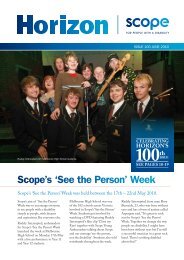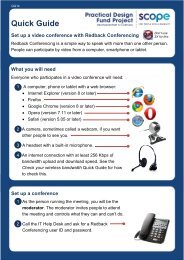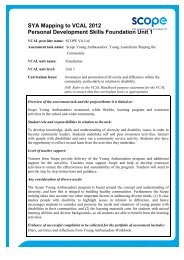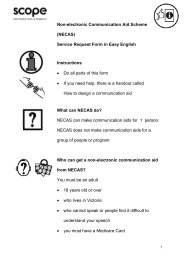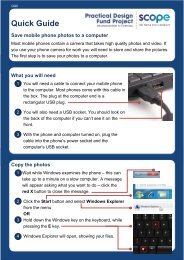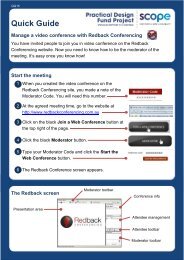Explainer: Technical terms - Scope
Explainer: Technical terms - Scope
Explainer: Technical terms - Scope
- No tags were found...
Create successful ePaper yourself
Turn your PDF publications into a flip-book with our unique Google optimized e-Paper software.
Communication<br />
3G, 4G – the wireless (radio) system used by mobile phones for speech, and by<br />
many computing devices for transmitting data. 3G and 4G signals can<br />
travel a long way. Phones and tablets often connect directly with 3G<br />
and 4G, but computers usually need a USB device called a 3G<br />
dongle.<br />
Network – two or more computers connected together, including the cabling<br />
and other equipment that makes it work.<br />
USB –<br />
Wi-fi –<br />
a way of connecting devices to computers. A USB cable is usually<br />
plugged into the computer and device, although some devices like<br />
USB flash drives plug directly into the computer without a cable.<br />
the wireless (radio) system that computers use to talk to local<br />
networks. Wi-fi can be very fast but its radio signals don’t travel far.<br />
Storage<br />
Compact disc (CD) – a 12cm flat disc that stores music for playing on a CD<br />
player or stores data for reading by computers. Usually stores around<br />
74 minutes of music or 700MB of data.<br />
Digital versatile disc (DVD) – disc that looks almost identical to a CD but<br />
stores video for playing on a DVD player or stores data for reading by<br />
computers. A DVD stores much more than a CD – usually two hours<br />
of video or 4.7GB of data.<br />
Flash drive – a small and portable solid state drive (see below) that connects to<br />
the computer’s USB port.<br />
Hard drive – a physical device for storing computer files. Usually 3.5” or 5”<br />
wide, hard drives can be installed into computers or in portable cases.<br />
Most hard drives contain disks that spin at high speed, and store files<br />
using magnetism.<br />
Solid state drive (SSD) - newer hard drives have no moving parts – they are<br />
made of solid silicon. They’re very fast, use less power and are hard to<br />
break. They’re also very expensive.



